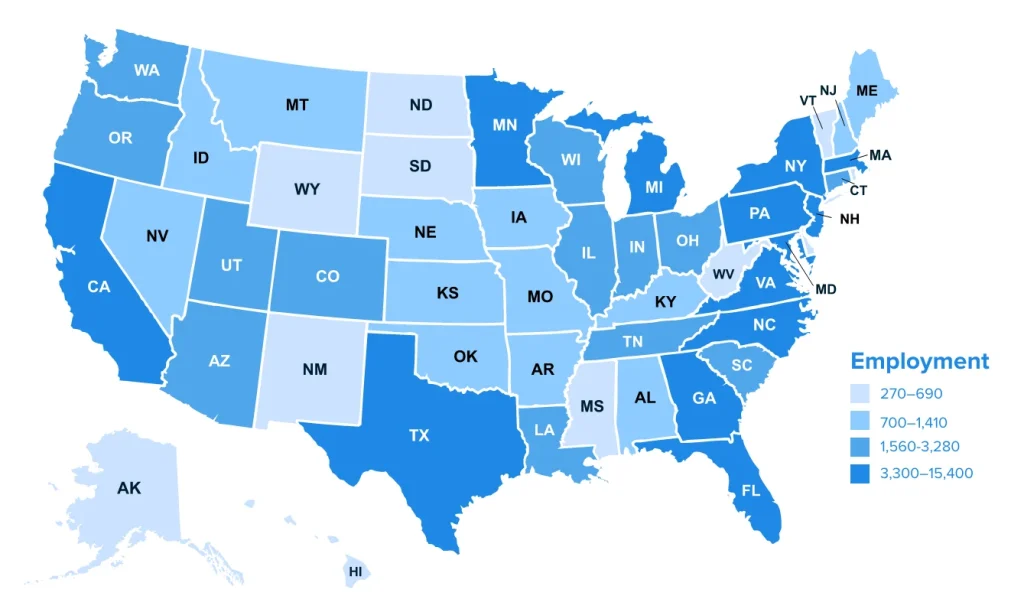A Complete Guide to Rewarding Physician Assistant Careers
Dive into the complete guide, where we help you navigate the ins and outs of PA jobs, including obtaining licensure, finding the right work environment, and more!
Start your FREE PA QBank trial to get one step closer to your dream physician assistant career.

Take a look at various Physician Assistant careers to find your true calling. No matter which field you choose, you'll have the opportunity to make a significant impact in the healthcare industry. Discover the dynamic environment of PA jobs, diverse specializations, and national averages to help you make informed decisions.
Educational Requirements for Physician Assistants
Becoming a Physician Assistant (PA) is an exciting path that requires specific undergraduate and graduate coursework before taking the PANCE to obtain licensure and certification. Aspiring PAs like yourself can choose between multiple educational paths, including:
- Earning a Bachelor's degree in a STEM field
- Enrolling directly in a Baccalaureate PA program from high school
- Gaining medical workforce experience before pursuing your graduate PA studies
Then, you'll dive into acquiring patient care experience and taking the graduate admissions test to qualify for candidacy to PA Master's Programs. Once enrolled, you'll complete your graduate coursework and hands-on clinical rotations to help you prepare for the PANCE.
Licensing and Certification Path to a Physician Assistant Career
This immersive journey typically takes 6-7 years from undergraduate to PA-C (Physician-Assistant Certified). Once licensed, you'll continue professional development to maintain your credentials. Completing a PA Master's Program and passing the PANCE ensures you'll have the necessary knowledge and skills to provide exceptional healthcare services.
What you need to know about the PANCE
The PANCE (Physician Assistant National Certifying Exam) is the licensure test the National Commission administers to PA program graduates. This comprehensive exam checks your medical knowledge and clinical skills. Picture this: multiple-choice questions covering everything from emergency medicine to surgery and everything in between. A score of 350 or above is needed to pass the PANCE and become a licensed PA.
The dynamic work environments available to physician assistants
Physician Assistants operate in various healthcare settings like hospitals, offices, and urgent care centers. You could even choose a role in rural or underserved areas where you can provide essential primary care services that make a significant impact. PA’s embrace dynamic and team-based work environments, adapting to different specialties and patient populations as they progress in their careers.

PA job responsibilities
| Patient Examination and Diagnosis: | Conduct thorough medical examinations, take patient histories, and assist in diagnosing medical conditions. |
| Patient Education: | Educate patients on their medical conditions, treatment plans, and preventive healthcare measures. |
| Record Keeping: | Maintain up-to-date medical records and document patient information, diagnoses, and treatment plans. |
| Treatment Planning: | Develop and implement treatment plans with supervising physicians, including prescribing medications and providing therapies. |
| Collaboration with Healthcare Team: | Collaborate with physicians, nurses, and other healthcare professionals to ensure comprehensive patient care. |
| Health Promotion: | Promote health and wellness through patient education, preventive care, and lifestyle counseling. |
| Surgical Assistance: | Assist in surgical procedures by performing suturing, wound care, and pre-operative and post-operative care. |
| Emergency Care: | Respond to emergencies, provide initial care, and stabilize patients before additional medical assistance. |
| Specialty Focus: | Responsibilities may include specific tasks related to the chosen medical field, such as cardiology or dermatology. |
| Medical Procedures: | Perform various medical procedures, including injections, immunizations, and minor surgical interventions. |
| Follow-up Care: | Monitor and manage ongoing patient care, track progress, and adjust treatment plans. |
| Clinical Research: | Some physician assistant jobs require clinical research and participation in studies or trials related to their field of expertise. |
Diverse Specializations in Physician Assistant Careers
The expansive range of specializations in the PA profession allows you to adapt and excel across a healthcare domain that's right for you. Whether delivering acute care or assisting in high-impact surgical procedures, you'll build experience within this diverse medical landscape. Other PA specialties include:
- Primary care
- Family medicine/general practice
- Emergency medicine
- Orthopaedic surgery
- Internal medicine- general practice
- Dermatology
- Hospital medicine
- Cardiothoracic and vascular surgery
- General surgery
- Cardiology
- Neurosurgery
- Psychiatry
- Critical care medicine
- Pediatrics- general
- Oncology
- Oncology
- Pain medicine
- Occupational medicine
- Obstetrics and gynecology
- Urology
- Plastic surgery
- Otolaryngology
- Neurology
- Geriatrics
- Physical medicine/rehabilitation
National Estimates for Physician Assistants
Geographic Profile for Physician Assistant Jobs
Understanding the geographic profile of PA jobs is vital to helping you navigate the abundance of healthcare opportunities. Physician assistant jobs tend to have higher concentrations in urban settings with diverse medical specialties, driven by the wide availability of healthcare facilities and resources. Take a look at the geographic makeup of Physician Assistants below to start planning your future career today!
Physician assistant careers in underserved communities
Another aspect to consider is the increased availability of PA jobs in rural districts with healthcare disparities. Limited access to medical facilities and shortages of healthcare professionals make it difficult for communities in provincial areas.
While these regions often face challenges in attracting and retaining clinical workers, they present unique opportunities for PAs to have a substantial influence. You can be pivotal in addressing healthcare gaps and improving access to medical services. Your contribution can be instrumental in improving health outcomes for underserved communities!
| National Rural Health Metrics | Rural Areas | Urban Areas |
| Percentage of population | 19% | 81% |
| Population aged 65 or older | 18% | 12% |
| Adults who describe health status as fair or poor | 20% | 16% |
| Adolescents who smoke | 11% | 5% |
| Male life expectancy | 76% | 74% |
| Female life expectancy | 81% | 80% |
| Percentage of dual-eligible Medicare beneficiaries | 30% | 70% |
| Medicare beneficiaries without drug coverage | 43% | 27% |
| Percentage covered by Medicaid | 16% | 13% |
Career Advancement for Physician Assistants
Proper planning can greatly contribute to professional growth for your physician assistant career. Pursuing a Doctorate and additional certifications deepens your knowledge and opens doors to specialized roles. You can also dedicate your time to serving committees that develop your leadership skills. For example, joining the Legislative Affairs Committee allows you to advocate for healthcare policies and actively participate in shaping the future of medicine.
Additionally, you can even consider a transition into academia or research. Contributing to education or engaging in research projects paves the way for job growth. Explore a handful of topics that enthusiastic PAs like you can research to potentially propel your career:
| Clinical Outcomes Research: | Evaluate the effectiveness of specific medical treatments or interventions, improving patient outcomes. |
| Pediatric Care: | Investigate interventions to enhance care practices for pediatric patients. |
| Chronic Disease Management Studies: | Explore innovative approaches to managing chronic conditions, improving patient adherence to treatment plans, and optimizing long-term health outcomes. |
| Cultural Competency Training: | Assess the effectiveness of cultural competency training programs for healthcare professionals. |
| Geriatric Care Models: | Research and implement effective care models for the senior population, emphasizing patient-centered approaches. |
| Preventive Care in Underserved Communities: | Contribute to initiatives that increase access to medical care in underserved communities. |
Is Becoming a Physician Assistant a Viable Career Option in 2024?
As our aging population expands and healthcare complexities increase, there's been a surge in demand for PAs across various medical fields. PAs continue to play a pivotal role in the healthcare system, offering a versatile skill set that caters to the ever-evolving patient needs.
Benefits of pursuing a PA job
Physician Assistant careers are rewarding and invigorating. Every day is a new challenge! Let's explore some of the most exciting aspects of being a PA:
- Dynamic environment
- Collaborative team-based approach
- Meaningful impact
- Competitive salaries
- Career advancement opportunities
- Work-life balance
Key points: dive into a rewarding physician assistant career
Aspiring PAs like you can choose between various educational paths and diverse healthcare settings. After earning your PA-C license and certification, explore the flexible options, career advancement opportunities, and competitive salaries the PA profession can offer you.
Ready to launch your career? Expertly prepare for didactics, clinicals, PANCE, PANRE, and beyond. Get started today!

References
- American Academy of PAs. (n.d.). What is a PA? AAPA.
https://www.aapa.org/about/what-is-a-pa/#:~:text=It%20represents%20a%20profession%20of,territories%2C%20and%20the%20uniformed%20services - Data USA. (n.d.). Physician Assistants.
https://datausa.io/profile/soc/physician-assistants#:~:text=The%20workforce%20of%20Physician%20assistants,for%20Physician%20assistants%20is%20White. - The Clinical Advisor. (n.d.). NCCPA report details trends in the PA
profession.
https://www.clinicaladvisor.com/home/news/nccpa-report-trends-pa-profession/#:~:text=The%20PA%20profession%20grew%20by,of%20Physician%20Assistants%20(NCCPA). - U.S. Bureau of Labor Statistics. (2021).
Occupational Employment and Wage Statistics: Physician
Assistants.
https://www.bls.gov/oes/2021/may/291071sl.htm - American Academy of PAs. (2018, June). PAs
in rural locations ready to meet primary care needs. AAPA.
https://www.aapa.org/news-central/2018/06/pas-rural-locations-ready-meet-primary-care-needs/example
